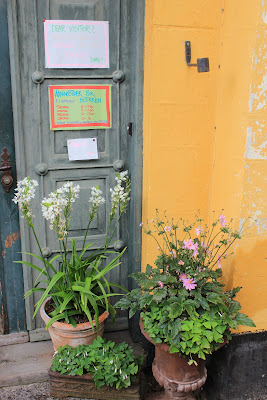29 September 2012
Here's the thing - being on exchange completely warps your sense of time. I think it's because (to recall my one and only economics course) the opportunity cost of my time here is absolutely zero. So where back home, I would never consider travelling for 3 hours each way to visit a place for a couple of hours, in Denmark it seemed like a completely reasonable way to spend my Saturday.
Ribe (pronounced Ree-buh) is pretty much on the exact opposite side of Denmark from Copenhagen, which makes it a 3 hour train ride. However because of a slight problem with the trains (and when I say "with the trains" I mean, more specifically, us looking at the arrivals board instead of the departures board) it took quite a bit longer to reach our destination.
But it was well worth it.
Ribe is the oldest town in Denmark, with the earliest reference to its existence dating to 854AD. It is completely adorable - built along the banks of a bubbling brook (a phrase that I never truly understood until visiting Ribe) with over 100 houses on the Danish Heritage List. Continuing with the ancient theme, there is hardly a square metre of pavement to be seen - go cobble or go home.
 |
| Autumn in Denmark mostly means people putting pumpkins everywhere. |
 |
| Also haybales. |
 |
| More haybales. |
The Ribe Cathedral
Ribe pretty much exists because of this bad boy. It was, at some point, the most northerly church in Europe when Ansgar (the Archbishop of Hamburg) decided that the deviant Danes needed some Jesus-love.
Apparently features which are good in highways are also desired in cathedrals, because one of the "notable features of the Ribe Domkirche (the fancy Danish name) is that is has 5 lanes. It wasn't set up like that when I was there, but maybe pews were narrower back in the day? The other exciting things about the Ribe Cathedral are the bells. There are 6 in total, and they place a Danish folk song ("Queen Dagmar lies in Ribe sick"for the Danish folk-song enthusiasts out there)
We wanted to climb the tower, but the scaffolding isn't just for show and they were doing some kind of significant repairs which meant it was off limits. Tres unimpressed, so instead we were stuck wandering around inside the building.
 |
| These are in *every* church in Denmark, and symbolise a safe journey to heaven/afterlife . |
Ribe Monastery (St Catherine's Church and Monastery)
And with any self-respecting cathedral must come a monastery. St Catherine's is built on a beautiful piece of land next to the river. And then it was rebuilt. And rebuilt. Because as it turns out, building on swamplands next to rivers is a really bad idea. But it turns out third time is the charm, and St Catherine's hasn't been flooded or sunk (yet). |
| There was an arts and crafts market on while we were there. |
 |
| The front two pews are always reserved for the royal family, just on the off chance that they pop in. |
*may not actually be called the Ribe River.
So Ribe is pretty much built on a flood plain, but at least it's pretty.
One of Ribe's most important history events is The Great Drowning of 1634, when a storm surge raised water levels over 6m above the banks of the river. Over 8000 men, women and horses/misc farm animals were washed away.
 |
| The waterfront in Ribe. |
 |
| The flames make it go faster. |
 |
| Stormflodssøjlen - the Storm surge pole which shows the flood peak from 1634 |
The Doors of Ribe
No, I'm not being facetious at all. The doors of Ribe are apparently quite a drawcard for the town, if the many souvenir shops selling post cards, posters and miniature replicas can be believed. I wouldn't be surprised if they have a "Doors of Ribe" Calendar.
 |
| Danish as fuck. |

































No comments:
Post a Comment